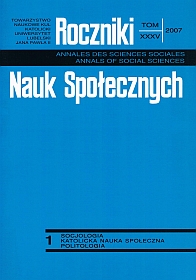The Demographic Problem of Poland
Abstract
The introductory part of the paper focuses on the demographic transformations in Poland in the first half of the twentieth century. The evolution of natural movement has been especially stressed here. In that period, the population of Poland had a very high birth rate. It followed from the dwindling but always high number of births, and the lowering death rate. The political and military events of the First and Second World Wars had brought about essential consequences. Especially the Second World War was fraught with consequences. As a result of demographic losses and changes of borders, the population of Poland diminished from 34.8 million (1939) to 23.9 million (1946). Then for a dozen of so years compensatory processes took place, which have recompensed the war losses. During further decades we dealt with a constant fall of the birth rate. It resulted from a diminished number of children. In the beginning of the 1990s, the population of Poland reached 38 million of inhabitants. The political transformation that took place in the last decade of the twentieth century have brought about far-reaching demographic results. A rapid fall of the birth rate, with the death rate at the same level, have made the birth rate dwindle. As a result, the demographic regress took place. The de-population processes embraced the majority of the country. In the final part of the paper the author arrives at a conclusion that these new tendencies in the natural movement are permanent. To prove this point we have one of demographic prognosis. According to its presuppositions, the population of Poland will diminish to the level of 26.3 million in 2050. The author claims that it will cause essential geopolitical, social, and economic consequences.
References
Buzek J., Pogląd na wzrost ludności ziem polskich w wieku XIX, Kraków 1915.
Eberhardt P., Nowe tendencje w ruchu naturalnym ludności, w: Człowiek iPrzestrzeń, Kraków IGiGP UJ 2001.
Eberhardt P., Nowe tendencje w ruchu naturalnym ludności Europy w ujęciu geograficznym, „Przegląd Geograficzny” 74(2002), z. 2, s. 175-198.
Frątczak E., Przemiany płodności i rodziny w Polsce i w Europie, w: Procesy demograficzne u progu XXI wieku. Polska a Europa. I Kongres Demograficzny w Polsce, t. XVII, red. Z. Strzelecki, Warszawa 2003.
Gieysztorowa I., Badania nad historią zaludnienia Polski, „Kwartalnik Historii Kultury Materialnej” 3-4(1964), s. 523-52.
Halik J., Starzy ludzie w Polsce. Społeczne i zdrowotne skutki starzenia się społeczeństwa, Warszawa 2002.
Historia Polski w liczbach. Ludność. Terytorium. Warszawa 1993.
Historia Polski w liczbach. Państwo i społeczeństwo, t. I, Warszawa 2003.
Janczak J. K., Statystyka ludności Królestwa Polskiego w drugiej połowie XIXw., „Przeszłość Demograficzna Polski”, t. XIX, Warszawa 1994, s. 47-116.
Jelonek A., Ruch naturalny ludności Polski w latach 1947-1955, „Dokumentacja Geograficzna” 1957, z. 6.
Jelonek A., Ruch naturalny ludności Polski w latach 1948-1988, „Zeszyty Naukowe Uniwersytetu Jagiellońskiego. Prace Geograficzne” 1992, z. 2.
Jelonek A., Zborowski A., Urbanizacja a ruch naturalny w Polsce, Warszawa 1983.
Krzyżanowski A., Kumaniecki K., Statystyka Polski, Kraków 1915.
Kurek S., Przestrzenne zróżnicowanie starzenia się ludności Polski w układzie miast i gmin w 1988-1998, w: Proces starzenia się ludności, red. J. T. Kowalski, P. Szukalski, Łódź 2000.
Kurkiewicz J., Modele przemian płodności w wybranych krajach europejskich w świetle drugiego przejścia demograficznego („Zeszyty Naukowe. Monografie A. E.” 1998, nr 131.
Okólski M., Reprodukcja ludności a modernizacja społeczeństwa. Polski syndrom, Warszawa 1988.
Okólski M., Modernizacja społeczeństwa a przejście demograficzne, w: Teoria przejścia demograficznego, Warszawa 1990, s. 14-117.
Okólski M., Demografia. Podstawowe pojęcia, procesy i teorie w encyklopedycznym zarysie, Warszawa 2004.
Piesowicz K., Ważniejsze zmiany w zaludnieniu ziem polskich w czasie IIwojny światowej, „Studia Demograficzne” 1988, nr 3(93), s. 77-123.
Procesy demograficzne u progu XXI wieku. Polska a Europa. Rządowa Rada Ludnościowa, red. Z. Strzelecki, t. XVII, Warszawa 2003.
Przemiany demograficzne w Polsce w latach 90. w świetle koncepcji drugiego przejścia demograficznego, red. I. E. Kotowska, Warszawa 1999.
Roset E., Proces starzenia się ludności, Warszawa 1959.
Sobczak I., Starzenie się ludności w wieku produkcyjnym w Polsce. Czynniki starzenia się ogółu ludności, w: Proces starzenia się ludności, red. J. T. Kowalski, P. Szukalski, Łódź 2000.
Szulc S., Ruch naturalny ludności w Polsce w latach 1895-1935, Warszawa 1936.
Van de Kremp, Lesthaeghe R., Twee demografische transities, red. I. Van Loghem-Slaterus, w: Bevolking: groei en krimp, Deventer 1986.
Vielrose E., Elementy ruchu naturalnego ludności, Warszawa 1961.
Wakar W., Rozwój terytorialny narodowości polskiej, cz. 1-3, Warszawa 1917, Kielce 1918.
Wawrzyszak K., Proces transformacji demograficznej we współczesnej Polsce (maszynopis), Lublin: WNS KUL 2004.
Wyrobisz S., Polska czterdziestomilionowa, Warszawa 1973.
Zamorski K., Informator statystyczny do dziejów społeczno-gospodarczych Galicji, Kraków–Warszawa 1989.
Copyright (c) 2007 Roczniki Nauk Społecznych

This work is licensed under a Creative Commons Attribution-NonCommercial-NoDerivatives 4.0 International License.


